banking mergers and acquisitions, including the biggest to date –
the $103 billion ABN AMRO purchase by the Royal Bank of
Scotland-Santander-Fortis consortium. But which, overall, was the
best M&A deal of the year? The winner will be announced at the
RBI awards ceremony on 2 April.
In terms of sheer drama alone, the most noteworthy banking
M&A deal from 2007 has to be the sale of ABN AMRO to the Royal
Bank of Scotland (RBS)-led consortium for $103 billion, a record
price for one of the most famous banking brands in the world. The
deal will transform RBS, Santander and Fortis, though integrating
the various ABN AMRO units will take up to three years – less for
Spain’s Santander, however, after its rapid sale of ABN AMRO’s
Italian subsidiary, Banca Antonveneta, to Banca Monte dei Siena di
Paschi for a tidy, near-€3 billion ($4.74 billion) profit.
Both deals – the RBS consortium’s purchase of ABN AMRO and
Santander’s subsequent sale of Antonveneta – have been shortlisted
in the RBI banking awards (see table in Retail banking
excellence). The other three nominees are Citi’s acquisition
of Japanese brokerage house Nikko Cordial (see Citi’s bold aims
for Japan’s retail market), ING’s all-out purchase of Turkey’s
Oyak Bank for $2.67 billion (see RBI 586) and
Toronto-Dominion’s $7.7 billion swoop on Commerce Bank in the US
(see RBI 580).
In their respective 2007 reports, RBS, Santander and Fortis all
claim that the integration of ABN AMRO’s various subsidiaries are
on track. Fred Goodwin, group chief executive of RBS, said: “The
integration has made a strong start. We now expect to achieve cost
savings totalling €1.6 billion in three years, 21 percent more than
we originally indicated. We have identified another €100 million of
net revenue benefits in Global Banking & Markets and €200
million in the International Retail businesses, bringing the total
for net revenue benefits we expect to achieve in three years to
€688 million. All told, integration benefits are now expected to
total €2.3 billion, compared with our original estimate of €1.7
billion.”
According to Goodwin, applying these increased synergies to the
financial targets originally announced in RBS’s offer will yield
increased accretion in adjusted earnings per share of 9 percent, a
return on investment in 2010 of 16 percent and an internal rate of
return of 18 percent. For 2007 as a whole, the ABN AMRO businesses
that will be retained by RBS made an underlying operating profit of
£439 million ($878 million).
How well do you really know your competitors?
Access the most comprehensive Company Profiles on the market, powered by GlobalData. Save hours of research. Gain competitive edge.

Thank you!
Your download email will arrive shortly
Not ready to buy yet? Download a free sample
We are confident about the unique quality of our Company Profiles. However, we want you to make the most beneficial decision for your business, so we offer a free sample that you can download by submitting the below form
By GlobalDataThe ‘winner’ of the ABN AMRO deal
Santander is on the M&A Deal of the Year shortlist twice. A
spokesperson for the bank told RBI: “Even before the sale
of Antonveneta in Italy for a 50 percent profit, Santander was
widely acclaimed the ‘winner’ of the ABN AMRO takeover. Santander’s
acquisition of [ABN AMRO’s] Banco Real in Brazil… more than doubled
its size in Brazil and provided the critical mass needed to remain
competitive. Once Real becomes part of the group, Santander will be
the second bank in Brazil by deposits and third by branch network
and loans. No other international bank has managed to establish a
remotely similar position in the country.”
Italy’s third-largest bank
For Banca Monte dei Siena di Paschi, buying Antonveneta has formed
the third-largest banking group in Italy. At the time of the deal
in November, many analysts said Monte dei Siena di Paschi had paid
over the odds for Antonveneta – Antonveneta’s net profit for the
first half of the year was only €150 million. Rating agencies
responded by cutting Monte dei Siena di Paschi’s rating and its
shares fell 11 percent on the day following the announcement,
giving it a market capitalisation at the time of around €9.2
billion – essentially the same value it placed on Antonveneta, a
bank with half the branches. Monte dei Siena di Paschi is paying
about €9 million per Antonveneta branch, increasing its network to
3,000 branches (1,000 from Antonveneta).
The Antonveneta deal caps a tumultuous 12-month period for the
Italian banking industry, a period which has seen, among other
deals, the purchase of fourth-largest player Capitalia by UniCredit
and the completion, on 1 January 2007, of the merger of Banca
Intesa and San Paolo IMI into Intesa Sanpaolo. According to figures
from Thomson Datastream, UniCredit and Intesa Sanpaolo are now
Europe’s third- and fourth-largest banks by market capitalisation;
as of the start of March this year, UniCredit was valued at nearly
twice that of the UK’s Barclays.
Separate figures from Reuters estimate that around €160 billion of
banking M&A has taken place in Italy since the start of
2006.

One of the US’s most retail-minded
banks
For Toronto-Dominion, Canada’s second-largest financial services
group, buying Commerce Bank has given it one of the most
retail-minded banking businesses in the US. The addition of
Commerce Bank doubles the size of TD’s existing US retail business,
TD Banknorth. It now has more than 2,100 branches in North America
(444 from Commerce), making it the seventh-largest bank in North
America by number of branches. For the past two years, Commerce
Bank, which markets itself as ‘America’s Most Convenient Bank’, has
won numerous awards for its ‘power banking’ and customer-centric
retail banking strategy, including Best Retail Bank – Americas and
Best Branch Strategy at RBI’s global retail banking awards
in 2006 (see RBI 563). One of this year’s judges said:
“Toronto-Dominion’s purchase of Commerce gives it, in a flash, one
of the fastest-growing retail banking franchises in the US.”

Citi’s fast-expanding Japan business
Citi’s share-based purchase of Japanese brokerage Nikko Cordial for
$4.8 billion and the subsequent consolidation of Citi’s
fast-expanding Japanese banking businesses into a new holding
company, Nikko Citi Holdings, effective from 1 May this year, have
further cemented its position as the leading non-Japanese retail
banking player in the country. The alliance between Nikko Cordial’s
leading retail brokerage business and Citi’s established retail
banking and credit card businesses will enable the combined
franchise to offer retail customers a comprehensive set of products
and services, including brokerage, funds, deposits, foreign
exchange, loans and credit cards.
The investment in Nikko Cordial has secured significant access to
Japan’s potentially huge market for selling investments to retail
customers. A recent survey by Japan’s Central Council for Financial
Service Information found that $7.2 trillion – over half of Japan’s
total household assets – was held by consumers in low-yielding
deposit accounts. If the US financial services giant can get hold
of a decent chunk of those underperforming savings, the price could
be a bargain.
ING’s push in Turkey is the Dutch group’s most ambitious
international retail banking acquisition to date (see RBI
586), and ING has outlined a bullish five-year vision for Oyak
Bank, its new Turkish subsidiary. The plan commits the
bancassurance giant to invest $900 million in Oyak up to 2013 with
a goal to double its current 3 percent share of the retail lending
market.
ING, which makes one-fifth of its profit from retail banking, told
RBI it will add 150 branches to the bank’s existing 365
outlets in the next three years – 50 more than it announced at the
time of the deal. ING said Turkey will become the world’s
12th-largest economy over the course of the next decade. Its GDP
growth in 2006 was 6.1 percent and is expected to grow at above 5
percent for the next three years.
A number of major transactions did not make the final RBI
M&A awards list: the formation of the biggest banking group in
the United Arab Emirates following the merger of National Bank of
Dubai and Emirates Bank; Société Générale taking control of Rosbank
in Russia; UniCredit eliminating rival Capitalia from the Italian
market for €22 billion (not to mention UniCredit’s bold Kazakhstan
acquisition, ATF Bank, back in June); Bank of America’s $21 billion
purchase of Chicago-based La Salle from ABN AMRO as well as its $4
billion ongoing purchase of Countrywide Financial; Wachovia’s
acquisition of leading US brokerage AG Edwards; and HSBC’s takeover
of The Chinese Bank in Taiwan – for which HSBC was paid $1.5
billion by the Taiwanese authorities.
And what about the deal that never was: Barclays’ initial plans to
merge with ABN AMRO? It didn’t work out – a lower price rarely wins
shareholder approval – but Barclays was astute enough to get a
welcome €200 million consolation break-off fee.









